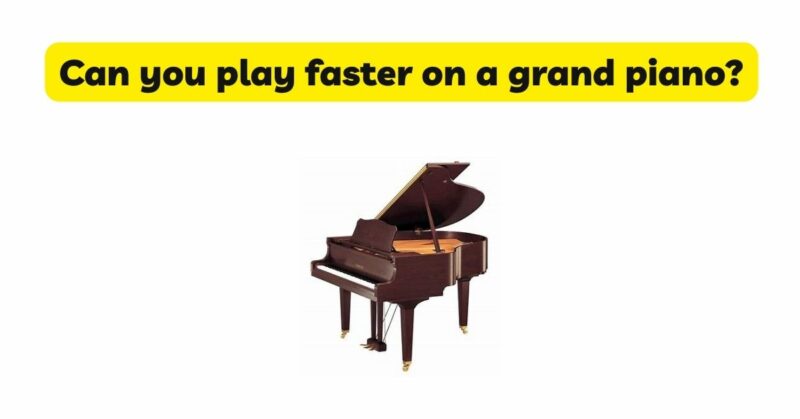Speed and agility are highly desirable attributes for pianists seeking to perform technically demanding pieces. In the world of piano playing, the question arises: does playing on a grand piano offer an advantage in terms of speed? In this article, we will delve into the factors that influence speed on the grand piano and examine the unique characteristics of this instrument that contribute to its potential for faster playing. By exploring key aspects such as key action, touch sensitivity, key length, and sonic capabilities, we aim to shed light on the relationship between grand pianos and the pursuit of speed in piano performance.
- Key Action and Touch Sensitivity: Key action plays a significant role in the speed and responsiveness of a piano. Grand pianos typically feature a sophisticated mechanism known as the grand action, which offers precise control and swift repetition of notes. This mechanism, often referred to as the “accelerated action,” allows for quick key return, reducing the time required for a pianist’s fingers to reset and facilitating faster execution of rapid passages. The sensitive touch of a grand piano’s keys enables pianists to achieve greater control over their technique, resulting in increased speed and agility.
- Key Length and Leverage: The length of the keys on a grand piano contributes to the potential for faster playing. Grand piano keys are typically longer than those of upright pianos or digital keyboards. The increased key length provides more leverage and allows pianists to exert greater control over the keys, facilitating precise and rapid finger movements. With longer keys, pianists can generate the necessary force and leverage to execute fast passages with greater efficiency and accuracy.
- Sonic Capabilities and Resonance: The sonority and resonance of a grand piano contribute to its potential for achieving speed. The sound production mechanism of a grand piano involves hammers striking strings, creating rich and sustained tones. This inherent resonance enhances the clarity and projection of each note, allowing pianists to differentiate and articulate fast passages more effectively. The sustain and harmonics produced by the vibrating strings provide a sonic bedrock that aids in maintaining clarity and precision, even at rapid tempos.
- Dynamic Range and Articulation: Grand pianos offer a wide dynamic range, allowing for expressive playing and nuanced articulation. The ability to control and vary the volume and intensity of each note is vital when playing fast passages, as it helps maintain clarity and precision. The grand piano’s dynamic capabilities enable pianists to emphasize specific notes or passages within rapid runs, facilitating musical interpretation and adding depth to the performance.
- Practice and Familiarity: Familiarity with the instrument is crucial for achieving speed and agility. Pianists who have spent significant time practicing on a grand piano develop a sense of comfort and familiarity with its unique touch, key action, and overall responsiveness. The muscle memory developed through consistent practice on a grand piano translates into faster and more fluid playing. The intuitive understanding of the instrument’s nuances allows pianists to navigate complex passages with greater ease and accuracy.
- Technique and Training: While the grand piano’s inherent characteristics contribute to its potential for speed, it is essential to emphasize that technique and training play a fundamental role in achieving fast and accurate playing. Building strength, dexterity, and coordination through dedicated technical exercises and focused practice is essential for developing speed on any piano. Regardless of the instrument, honing one’s technique and cultivating efficient finger movements are critical factors in achieving speed and agility in piano performance.
- Individual Differences and Musical Context: It is important to note that the ability to play fast passages on a grand piano may vary among individuals. Factors such as hand size, finger flexibility, and overall physicality can influence a pianist’s capacity for speed. Additionally, the musical context in which speed is required also affects the perceived advantages of playing on a grand piano. Different musical genres and styles may demand varying degrees of speed, and the choice of instrument should align with the specific musical requirements and artistic vision of the pianist.
Conclusion: Playing on a grand piano offers unique advantages that can contribute to the potential for faster playing. The sophisticated key action, longer keys, enhanced touch sensitivity, and sonic capabilities of grand pianos provide pianists with the tools and conditions necessary to achieve speed and agility. The inherent resonance, dynamic range, and expressive possibilities of grand pianos further enhance the experience of playing rapid passages.
However, it is essential to recognize that speed in piano playing is a complex interplay of various factors, including technique, training, familiarity with the instrument, and musical context. While the grand piano offers inherent advantages, achieving speed ultimately depends on a pianist’s dedication, practice regimen, and ability to develop efficient finger movements and control.
Regardless of the piano type, the pursuit of speed in piano performance requires disciplined practice, attention to technique, and a deep understanding of musicality. The joy and artistry of piano playing lie in the hands of the musician, and the ability to achieve speed is a testament to the skill, dedication, and musical expression of the individual pianist.


